SUPER FOOD BY DR ANJANA SUBRAMANIAN
Understanding Superfoods: What Makes Food Super?
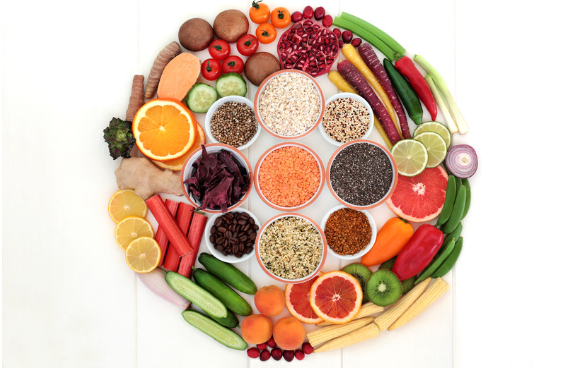
Superfoods are a trending topic in the world of health and wellness, but what exactly are they? Let’s dive into what qualifies as a superfood, the criteria for their selection, and why they are vital for our overall health.
What are Superfoods?
Superfoods are foods that contain higher-than-average levels of specific nutrients essential for the human body. These nutrients could include:
- Proteins
- Folate (Vitamin B9)
- Vitamin E
These foods stand out because they provide one or more nutrients in a concentrated form, making them highly beneficial for maintaining good health.
Is There a Specific Criteria for Superfoods?
Interestingly, there is no fixed criterion for labeling a food as a superfood. The list of superfoods often changes every few years as our understanding of food’s biochemical properties evolves. However, naturopathic physicians focus on three main qualities in foods to classify them as superfoods:
1. Antioxidant-Rich Foods
Antioxidants are compounds that protect our bodies by neutralizing harmful toxins (oxidants). These toxins can cause damage at the cellular level, leading to various diseases.
- Key Components Supporting Antioxidants:
- Superoxide Dismutase (SOD): A critical enzyme in the body’s scavenging system.
- Minerals like Selenium and Zinc: Found abundantly in nuts.
- Vitamins B and C: Essential for boosting the antioxidant system.
Examples of Antioxidant-Rich Foods:
- Fruits high in Vitamin C, like oranges and berries.
- Nuts containing Selenium, such as Brazil nuts.
2. Anti-Inflammatory Foods
Chronic inflammation is a root cause of many diseases. Consuming foods with anti-inflammatory properties helps reduce inflammation and promotes healing.
- Common Components of Anti-Inflammatory Foods:
- Omega-3 Fatty Acids: Found in fatty fish, walnuts, and flaxseeds.
- Flavonoids: Present in dark chocolate and various fruits.
3. Hepatoprotective Foods
Hepatoprotective foods protect and support the liver, which acts as the body’s project manager. A healthy liver ensures smooth bodily functions, especially digestion and detoxification.
- Importance of the Liver:
- It processes nutrients, removes toxins, and regulates metabolism.
- A well-functioning liver contributes to overall health and vitality.
Why are These Qualities Important?
Foods with these three qualities—antioxidant-rich, anti-inflammatory, and hepatoprotective—provide a holistic approach to health. They not only prevent diseases but also enhance the body’s ability to heal and maintain optimal functioning.
Superfoods are nature’s powerhouse, offering concentrated nutrients that support our overall well-being. Incorporating antioxidant-rich, anti-inflammatory, and hepatoprotective foods into your diet can significantly enhance your health. Remember, our understanding of food evolves, and what’s considered a superfood today may change tomorrow. However, focusing on these core qualities ensures you’re making informed, healthful choices.
Stay connected to your health and wellness journey by choosing foods that nourish your body and
The Evolution of Superfoods: A Journey from 1918 to Today

Superfoods have become a significant focus in modern nutrition, but the concept of “superfoods” has an interesting history. Here’s an exploration of how it began and how we use it today.
The Origin of Superfoods
- Before 1918, there was no specific term or classification known as “superfood.”
- Foods rich in essential nutrients were used for centuries, but they weren’t isolated or studied for their unique health benefits.
- By the 18th and 19th centuries, scientists started isolating specific compounds from foods to understand their effects.
- In 1937, during the Great Depression, bananas were recognized as an affordable and highly nutritious food. Their potassium and magnesium content made them the first food to be labeled as a “superfood.”
The Superfood Trend
- Since 1918, the list of superfoods has grown significantly.
- Every five years, new foods are added to this list based on scientific research.
- However, the “superfood” label doesn’t imply a comprehensive list of all beneficial foods. It is continuously evolving as research progresses.
Understanding Superfoods Scientifically
To identify and recommend superfoods effectively, a structured approach is required:
- Master Table of Compounds
- Foods are rich in various classes of compounds that cater to specific health needs.
- Left Column: Class of compounds such as antioxidants, carotenoids, or immune modulators.
- Right Column: Specific compounds under each class (e.g., beta-carotene for carotenoids).
- Matching Needs with Nutrients
- Toxic Load: For individuals exposed to high pollution (e.g., residents of Delhi), foods with antioxidants and hepatoprotective properties are essential to detoxify and protect the liver.
- Acute Allergies: Anti-inflammatory and immune-modulating foods can alleviate symptoms.
- Maintenance Phase: A combination of supportive nutrients helps maintain overall health.
- Prescribing Foods
- Once the required compounds are identified, foods rich in these compounds are recommended.
- This process ensures that food as medicine is applied scientifically and effectively.
Practical Application for Patients
Patients increasingly seek to use food as medicine. To meet this demand:
- Use a scientific framework like the master table to match foods to individual health needs.
- Focus on specific nutrient-rich foods that address conditions like inflammation, detoxification, or immune support.
The journey of superfoods highlights the importance of scientific validation in nutrition. Using tools like the master table of compounds, healthcare providers can offer precise and evidence-based dietary advice, ensuring food is not just sustenance but a tool for healing and health optimization.
Wheatgrass: The Superfood for Health and Vitality
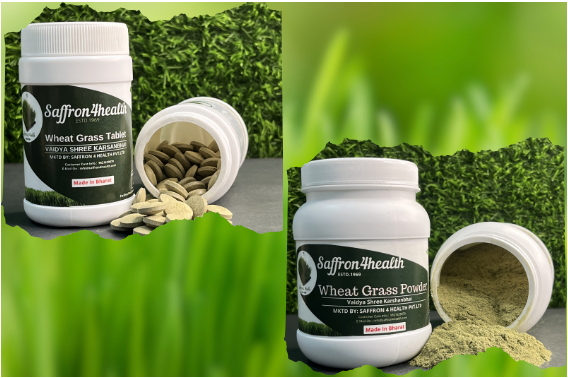
Wheatgrass, often referred to as “green blood,” is a powerhouse of nutrients that has gained global recognition for its health benefits. This freshly sprouted shoot of the wheat plant is not only low in gluten but also rich in chlorophyll, making it an essential addition to a health-conscious lifestyle. Below is an in-depth look at the benefits, scientific insights, and practical ways to incorporate this superfood into your daily routine.
What is Wheatgrass?
Wheatgrass is the young, green shoot of the wheat plant (Triticum aestivum). Known for its vibrant green color, wheatgrass is packed with nutrients and enzymes that offer numerous health benefits.
- Low Gluten Content: Unlike mature wheat grains, wheatgrass contains minimal gluten, making it suitable for those with gluten sensitivities.
- Rich in Chlorophyll: Often dubbed as “nature’s healer,” chlorophyll is structurally similar to hemoglobin, the oxygen-carrying molecule in our blood. This similarity allows chlorophyll to support oxygenation and energy levels in the body.
Key Nutritional Components of Wheatgrass
- Chlorophyll: Boosts oxygen transport and acts as a natural detoxifier.
- Flavonoids and Alkaloids: Possess anti-inflammatory and antioxidant properties.
- Enzymes and Amino Acids: Aid in digestion and cellular repair.
- Essential Vitamins and Minerals: Includes vitamins A, C, and E, as well as iron, calcium, and magnesium.
Health Benefits of Wheatgrass
1. A Natural Detoxifier
Wheatgrass aids in flushing out toxins from the body, primarily due to its chlorophyll content. It helps maintain the body’s pH balance, supporting kidney and liver function.
2. Boosts Hemoglobin and Oxygenation
The chlorophyll in wheatgrass mirrors the structure of hemoglobin, enhancing the body’s ability to transport oxygen. This leads to better energy levels and improved stamina.
3. Anti-Inflammatory Properties
Thanks to its alkaloids and flavonoids, wheatgrass helps combat inflammation. Studies have shown its efficacy in managing conditions like:
- Colorectal cancer
- Ulcerative colitis
- Gastric ulcers
4. Enhances Recovery Post-Chemotherapy
Wheatgrass reduces the toxic effects of chemotherapy, helping patients recover faster by balancing the body’s pH and boosting the immune system.
5. Alkaline Food for Better pH Balance
With a pH close to the body’s natural range (7.35-7.45), wheatgrass supports enzyme function and prevents life-threatening conditions caused by pH imbalances.
6. Balances Pitta Dosha (According to Ayurveda)
Wheatgrass is known to calm excess Pitta, which can cause skin issues, acidity, and digestive disturbances.
Scientific Insights
Modern research backs many of wheatgrass’s traditional uses:
- Cancer Support: Studies indicate that wheatgrass can be an effective adjunct treatment, especially for colorectal cancer.
- Digestive Health: Its anti-inflammatory properties make it beneficial for gastric and intestinal issues.
- Immune System Boost: Regular consumption strengthens immunity, aiding in faster recovery from illnesses.
How to Consume Wheatgrass
1. Fresh Wheatgrass Juice
- How to Make: Blend freshly harvested wheatgrass with water and strain the juice.
- Best Time: Consume on an empty stomach to maximize nutrient absorption and balance acid-alkaline levels.
- Tip: Drink within 20 minutes of preparation to retain its nutritional potency.
2. Wheatgrass Powder
- Usage: Mix the powder in water, smoothies, or juices.
- Convenience: Ideal for those with a busy lifestyle or limited access to fresh wheatgrass.
3. Supplements
- Available in capsule or tablet form, wheatgrass supplements are a convenient alternative for those who want precise dosages.
How to Grow Wheatgrass at Home
Growing wheatgrass is simple and cost-effective:
- Soak wheat seeds overnight.
- Spread the seeds evenly in a tray filled with moist soil.
- Keep in a well-lit area, but avoid direct sunlight.
- Water daily and harvest within 7-10 days.
Precautions
- Allergies: Some individuals may experience allergic reactions. Start with a small quantity to test tolerance.
- Interaction with Medications: Consult a healthcare professional if you are on medications or undergoing treatment for chronic illnesses.
- Dosage: Limit intake to 30-60 ml of fresh juice or 1-2 teaspoons of powder daily to avoid side effects like nausea or headaches.
Wheatgrass is a versatile superfood that offers a myriad of health benefits, from detoxification to anti-inflammatory effects. Its ability to support recovery, enhance oxygenation, and maintain pH balance makes it a vital addition to modern diets. Whether consumed fresh, as a powder, or in supplement form, wheatgrass is a step towards holistic health and well-being.
Start incorporating wheatgrass into your routine today and experience its transformative benefits!
The Wonders of Moringa: A Superfood with Endless Benefits
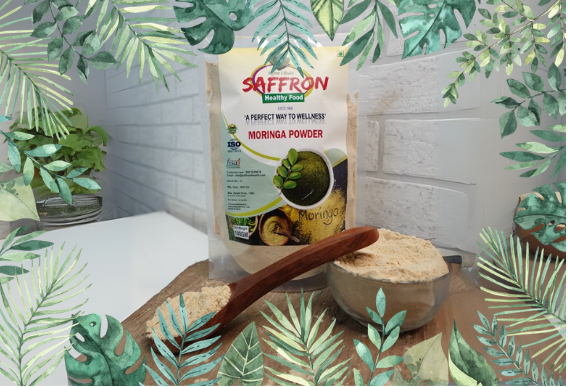
Moringa, commonly known as drumstick, has been revered for centuries as a nutrient powerhouse. Its scientific name, Moringa oleifera, highlights its global recognition as a “tree of life.” This article delves into its various components, benefits, and versatile uses.
Why Moringa is Called the Tree of Life
Moringa earns its title due to its vast array of beneficial properties:
- Rich Nutrient Profile: It contains over 100 different bioactive compounds.
- Every Part is Useful: Leaves, seeds, roots, and pods of the tree have distinct uses.
- High Protein Content: Ideal for vegetarians, it contains all essential amino acids.
Key bioactive components include:
- Muramoside A & B and Niazimin A & B: Potent antioxidants that contribute to its anti-cancer and immune-boosting properties.
Nutritional Highlights
Moringa is a rich source of:
- Chlorophyll: Often called “green blood,” it aids in detoxification.
- Potassium and Vitamin C: Essential for overall health.
- Healthy Fats: Seeds contain beneficial fats like palmitic acid.
- Protein for Vegetarians: Provides a complete amino acid profile, compensating for protein deficits in vegetarian diets.
Health Benefits
Moringa’s versatility makes it a vital addition to various health routines:
- Immune Booster: Its antioxidant properties strengthen immunity.
- Hepatoprotective: Protects and supports liver function.
- Anti-Hypertensive: Helps regulate blood pressure.
- Anti-Diabetic: Improves insulin sensitivity, making it a great protein source for diabetics.
- Kidney Health: Roots are particularly useful in managing kidney stones.
- Bronchitis Relief: Decoctions made from leaves alleviate bronchitis symptoms.
- Fertility Enhancer: Anti-inflammatory properties aid in improving fertility by balancing hormones.
Usage Beyond Eating
Apart from its dietary benefits, Moringa finds applications in traditional medicine:
- Poultice for Inflammation:
- Fresh leaves are used to create a compress to reduce swelling and pain.
- Effective for arthritis and injuries.
- Kidney Stone Prevention:
- Roots act as a preventive remedy.
- Bronchitis Treatment:
- Leaf decoctions soothe respiratory inflammation.
- Fertility Aid:
- Anti-inflammatory and protein-rich properties enhance reproductive health.
Moringa in Protein Management
For individuals with specific dietary needs:
- Vegetarians: A vital protein source, compensating for limited intake.
- Standard Rule for Protein Intake:
- 1 gram per kilogram of body weight is the recommended intake.
- Adjustments may be needed for aging individuals or those with conditions like CKD (Chronic Kidney Disease).
- CKD Management:
- Protein intake ranges from 0.5 to 1.2 grams per kg, depending on the stage of CKD.
Practical Applications
- Diabetes Management:
- Helps replenish protein loss and reduces ketone body excretion.
- Anti-Cancer Potential:
- High levels of antioxidants combat free radicals, reducing cancer risks.
- Protein Deficiency:
- Recommended for vegetarians or anyone with low protein levels, based on simple calculations or RDA tables by the National Institute of Nutrition.
Key Takeaways
- Tree of Life: Moringa stands out as a superfood with incredible benefits.
- Versatility: From diet to traditional medicine, its applications are endless.
- Nutritional Powerhouse: Rich in protein, vitamins, and antioxidants.
- Practical Benefits: Effective in managing diabetes, inflammation, and fertility issues.
Moringa truly lives up to its reputation as one of nature’s most valuable offerings, catering to dietary and therapeutic needs alike. Incorporate it into your routine to reap its full spectrum of benefits!
Turmeric: A Sacred Spice with Multifaceted Benefits
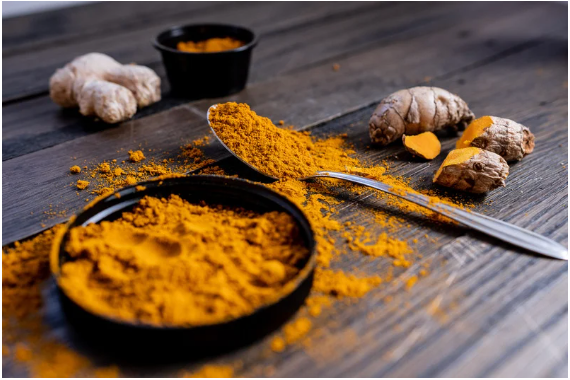
Turmeric, known scientifically as Curcuma longa, is an ancient spice that has been an integral part of Indian culture, cuisine, and traditional medicine for thousands of years. Its vibrant golden hue and numerous health benefits make it a staple in kitchens and wellness practices worldwide. This article delves deep into turmeric’s varieties, health benefits, historical significance, and practical applications.
The Science Behind Turmeric
- Botanical Profile:
- Turmeric belongs to the ginger family (Zingiberaceae).
- Its active compounds, curcuminoids, are responsible for its health-promoting properties.
- The primary bioactive compound is curcumin, a potent antioxidant and anti-inflammatory agent.
- Nutritional Value:
- Rich in essential vitamins and minerals.
- Contains volatile oils and antioxidants that contribute to its medicinal properties.
Varieties of Turmeric in India
India, being the largest producer of turmeric, boasts numerous varieties with varying curcumin content. Some notable ones include:
|
Variety |
Region |
Curcumin Content |
Significance |
|
Lakadong |
Meghalaya |
7-12% |
Known for its high curcumin content. |
|
Alleppey |
Kerala |
~5% |
Used for its medicinal and culinary purposes. |
|
Madras |
Tamil Nadu |
~3.5% |
Widely used in cooking. |
|
Erode |
Tamil Nadu |
3-4% |
Popular for its bright yellow color. |
|
Sangli |
Maharashtra |
Deep orange |
GI-tagged for its medicinal and color value. |
|
Nizamabad |
Telangana |
2-4% |
Cultivated for both culinary and medicinal use. |
Historical and Cultural Importance
- Sacred Status:
- In Indian culture, turmeric is considered sacred and is often used in religious rituals and ceremonies.
- It symbolizes purity, prosperity, and fertility.
- Ancient Wisdom:
- Ayurvedic texts mention turmeric as a remedy for various ailments, including digestive issues, skin disorders, and infections.
- It has been used for over 4,000 years as a therapeutic agent.
Health Benefits of Turmeric
- Anti-Inflammatory Properties:
- Curcumin inhibits inflammatory pathways, making turmeric effective for arthritis and other inflammatory conditions.
- Antioxidant Powerhouse:
- Protects cells from damage caused by free radicals, reducing the risk of chronic diseases.
- Supports Heart Health:
- Lowers cholesterol levels and prevents arterial plaque formation.
- Improves circulation and reduces the risk of heart diseases.
- Cancer Prevention:
- Studies show curcumin’s potential in preventing and inhibiting the growth of cancer cells.
- Boosts Immunity:
- Strengthens the immune system due to its antiviral, antibacterial, and antifungal properties.
- Aids Digestion:
- Stimulates bile production, aiding in the digestion of fats.
- Provides relief from bloating and gas.
- Skin and Wound Healing:
- Its antiseptic and anti-inflammatory properties make it effective for treating cuts, burns, and skin conditions.
Modern Research and Global Recognition
- In 2010, the FDA recognized turmeric’s therapeutic potential, particularly its curcumin content.
- Turmeric supplements, especially in capsule form, have become popular in Western countries for addressing inflammation and promoting overall health.
How to Use Turmeric
- Culinary Applications:
- Add to curries, soups, and beverages like turmeric lattes.
- Combine with black pepper to enhance curcumin absorption.
- Medicinal Uses:
- Paste or Poultice: Effective for joint pain and wounds. Apply directly to the affected area to draw out toxins and improve circulation.
- Golden Milk: Mix turmeric powder with warm milk, honey, and a pinch of black pepper for a soothing drink.
- Skincare:
- Mix turmeric with yogurt or honey for a natural face mask to brighten the skin and reduce inflammation.
- Supplements:
- Available in capsule form for those who need higher doses of curcumin for health conditions.
Stories of Turmeric in Action
- Traditional Indian households have long relied on turmeric as a go-to remedy. For example, applying turmeric paste on wounds was common due to its antiseptic properties.
- In Western countries, turmeric’s popularity surged when research highlighted its role in reducing inflammation and promoting longevity.
Turmeric in Modern Context
- Global Demand:
- Turmeric has become a key ingredient in health supplements and superfood powders.
- Countries like the US have adopted turmeric for its holistic benefits, often in concentrated forms like curcumin capsules.
- Sustainability:
- Efforts are being made to promote organic and sustainable farming of turmeric to meet increasing global demand.
Turmeric is more than just a spice; it is a treasure trove of health benefits and a symbol of cultural heritage. From ancient Ayurvedic practices to modern medical research, turmeric continues to hold a revered place in wellness and medicine. Incorporating turmeric into daily life can unlock its immense potential, supporting overall health and vitality. Whether as a seasoning, supplement, or skincare remedy, turmeric truly is a golden spice for holistic health.
The Benefits of Millets: A Nutrient-Packed Ancient Superfood
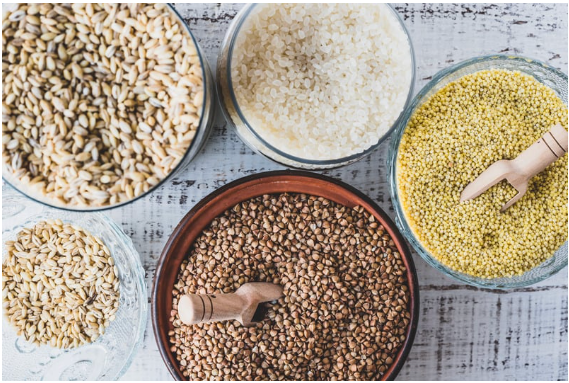
Millets, often considered an ancient grain, have been a staple in many parts of India for centuries. Despite being overshadowed by modern grains in recent decades, millets are regaining popularity due to their health benefits and nutritional richness. This article will explore the various benefits of millets, including their historical significance, nutritional profile, and specific varieties that contribute to better health.
What Are Millets?
Millets are small-seeded cereal grains that belong to the family Poaceae. These grains have been cultivated in India for thousands of years and were once the primary food source in many regions, especially in Southern and Western India. Despite the rise of wheat and rice, millets remain an integral part of the diet in several communities.
Key Types of Millets:
- Finger Millet (Ragi)
- Foxtail Millet
- Pearl Millet (Bajra)
- Sorghum (Jowar)
- Kodo Millet
These grains are highly versatile, used in various dishes such as porridges, rotis, upma, and even as a base for savory snacks.
Nutritional Profile of Millets
Millets offer an impressive array of nutrients. They are packed with essential vitamins, minerals, and antioxidants, making them a nutritious alternative to refined grains. Here’s a look at some key nutritional benefits of millets:
- Protein Content: Millets contain 7-12% protein, making them a good source of plant-based protein, especially for vegetarians and vegans.
- Calcium: Finger millet (Ragi), in particular, is rich in calcium, which supports bone health.
- Fiber: Millets are an excellent source of dietary fiber, which aids in digestion and helps maintain healthy blood sugar levels.
- Antioxidants: They are rich in antioxidants, which combat oxidative stress and reduce inflammation in the body.
The Health Benefits of Millets
1. Promotes Digestive Health
Millets are rich in fiber, which helps improve digestion and prevent constipation. For individuals with gluten intolerance or sensitivity, millets offer a great gluten-free alternative, promoting better gut health. Foxtail millet, for example, contains lecithin, a compound that supports digestive function by stimulating gastric secretion, aiding in the breakdown of food.
2. Supports Mood and Mental Health
Millets are a great source of tryptophan, an amino acid that acts as a precursor to serotonin, often referred to as the “happy hormone.” Higher serotonin levels can help alleviate symptoms of depression and anxiety. Regular consumption of millets may support better mood regulation and mental health.
3. Rich Source of Gluten-Free Protein
Millets provide an excellent source of protein for those who need to avoid gluten. Finger millet (Ragi) is particularly beneficial for individuals with gluten sensitivity, offering a wholesome, gluten-free grain option.
4. Promotes Bone Health
Certain varieties of millet, such as finger millet (Ragi), are rich in calcium, which is essential for strong bones and teeth. This makes millets an ideal choice for individuals, especially women, looking to improve bone density.
5. Weight Management
The high fiber content of millets helps promote a feeling of fullness, which can aid in weight management. They have a low glycemic index, meaning they cause a slower rise in blood sugar levels compared to refined grains, making them beneficial for managing blood sugar levels.
Millets and Autoimmune Health
Millets have also shown promise in managing autoimmune conditions. Their gluten-free nature makes them ideal for individuals with celiac disease or other autoimmune disorders that require a gluten-free diet. The antioxidants in millets help reduce inflammation, which can benefit those suffering from conditions like arthritis.
Millets in the Kitchen: Easy Recipes to Try
Millets are incredibly versatile and can be used in both savory and sweet dishes. Here are a few ideas to incorporate millets into your daily meals:
- Millet Porridge: A nutritious breakfast option, millet porridge can be made by cooking millet with milk or water, and adding fruits, nuts, and honey.
- Millet Roti: Substitute wheat flour with millet flour to make gluten-free roti, which pairs perfectly with curries and vegetables.
- Millet Upma: A healthy and quick breakfast dish, made by sautéing millet with vegetables and spices.
- Millet Khichdi: A comforting dish made with millet, lentils, and spices that’s easy on the stomach and aids digestion.
- Millet Flour Pancakes: Combine millet flour with spices and water to make gluten-free pancakes, ideal for breakfast or snacks.
Why You Should Include Millets in Your Diet
Millets are a nutritional powerhouse that can provide numerous health benefits. From supporting digestive health and managing weight to improving mood and mental well-being, millets are an excellent addition to a balanced diet. They are versatile, gluten-free, and packed with essential nutrients that can promote overall wellness. By incorporating millets into your meals, you can harness their potential to enhance your health, just as they have done for generations in India.
So, whether you’re looking to improve your digestive health, boost your mood, or simply try something new, millets offer a delicious and wholesome alternative to modern grains.
The Power of Amla: A Nutrient-Packed Superfood
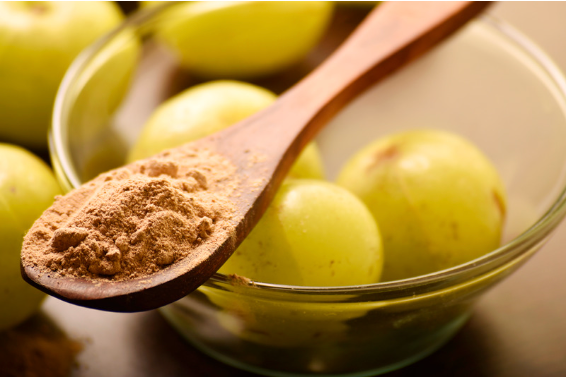
Amla, also known as Indian Gooseberry, is a remarkable fruit widely celebrated in Ayurvedic medicine for its diverse health benefits. Packed with essential nutrients, it supports immunity, digestive health, and overall wellness. This article explores the many ways amla can be incorporated into a daily health regimen, its health benefits, and important precautions to keep in mind.
Key Nutritional Benefits of Amla
- Rich Source of Vitamin C:
- Amla is incredibly rich in Vitamin C, containing over 40% of the daily recommended intake of this crucial vitamin.
- Vitamin C is a potent antioxidant that helps combat oxidative stress, support immune function, and enhance collagen production for healthier skin.
- Contains Essential Minerals:
- Amla is not only a Vitamin C powerhouse but also provides significant amounts of copper and manganese. These minerals are important for a healthy immune system and overall bodily functions.
- Improves Nutrient Absorption:
- Amla plays a key role in increasing the absorption of other nutrients. For instance, when taken with iron-rich foods, it enhances the body’s ability to absorb iron, making it particularly helpful for individuals with iron deficiency.
- Hepatoprotective Properties:
- Amla is known for its protective effects on the liver. It helps in detoxification and boosts liver health, improving the overall functioning of the digestive system.
How Amla Boosts Immunity
Amla’s high Vitamin C content makes it an excellent immune booster. It helps to prevent infections and supports the body’s ability to fight off common ailments such as colds and flu. By improving the availability of other immune-boosting herbs, such as Giloy, amla works synergistically with other natural remedies to enhance their effectiveness.
Popular Ways to Consume Amla
- Raw or in Juice Form:
- Amla can be consumed fresh or in juice form, providing the highest concentration of nutrients. However, care should be taken when drinking amla juice.
- Powdered Form:
- Amla powder can be mixed with water or added to smoothies, providing a concentrated form of the fruit that is easy to consume regularly.
- Amla in Herbal Blends:
- Amla is often included in herbal blends aimed at improving overall health. It pairs well with other herbs and spices, making it versatile in a variety of remedies.
Precautions to Take When Consuming Amla
While amla is beneficial, there are some important precautions to keep in mind:
- Avoid Mixing with Hot Water:
- Amla juice should not be mixed with hot water. The heat can denature the Vitamin C, making it less effective.
- Caution for Those with Digestive Issues:
- People suffering from Irritable Bowel Syndrome (IBS) or gastric ulcers should avoid consuming raw amla or its juice in large quantities. The high Vitamin C content may irritate the gut and worsen symptoms.
- Best Taken with a Citric Base:
- Amla is often paired with citrus fruits like lemon or orange to improve the absorption of iron, especially in individuals with iron deficiency anemia. This combination increases the effectiveness of both the Vitamin C and iron.
Amla in the Management of Iron Deficiency Anemia
Amla can play a key role in managing iron deficiency anemia due to its high Vitamin C content. Vitamin C enhances the body’s ability to absorb iron from plant-based sources, which is essential for individuals struggling with anemia.
- Effective Combinations:
- For those with low hemoglobin levels, a combination of amla, moringa, cinnamon, and sometimes brahmi can work wonders. These ingredients not only help in boosting iron levels but also support overall health.
- Amla can also be paired with ginger and Himalayan salt for an added boost in nutrient absorption.
Suggested Amla-Based Health Blends
- Moringa & Amla Blend:
- Moringa, which is known for its iron-rich properties, works well when combined with amla to provide a potent remedy for iron deficiency anemia.
- Amla with Cinnamon and Brahmi:
- For those dealing with anemia and B12 deficiency, adding amla with cinnamon and brahmi can help improve overall nutrient levels and support the nervous system.
- Green Blends:
- Amla is often included in green blends, which consist of a mix of nutrient-rich herbs and greens. These blends can be tailored to individual needs, offering a holistic approach to health.
Amla is undoubtedly a superfood that provides an array of health benefits. Its rich Vitamin C content, antioxidant properties, and ability to support nutrient absorption make it a valuable addition to any health routine. However, it’s important to consume it correctly and in moderation to avoid any digestive discomfort. By incorporating amla in various forms, from fresh fruit to powdered supplements or juices, you can unlock its full potential and support your health naturally.
The Holistic Benefits of Tulsi: A Sacred Herb for Wellness

Tulsi, also known as Holy Basil, has long been revered in India not only for its spiritual significance but also for its incredible medicinal properties. It’s an herb that has been deeply embedded in Ayurvedic practices for centuries, known for its ability to balance the body, mind, and spirit. Let’s explore why Tulsi is considered sacred and how it can benefit various aspects of health.
Tulsi: The Sacred Herb
Tulsi holds a special place in Indian culture, symbolizing purity and divinity. In Hinduism, it is considered a goddess, often planted in courtyards and worshipped in homes. The leaves of Tulsi are used in daily prayers and offerings, making it much more than just a medicinal herb.
Why is Tulsi Sacred?
- Spiritual Significance: Tulsi is believed to purify the environment and attract positive energies, removing negative vibrations from the surroundings.
- A Symbol of Protection: In Ayurveda, Tulsi is known for providing spiritual protection and promoting wellness by harmonizing the body’s natural energies.
Medicinal Benefits of Tulsi
Beyond its spiritual significance, Tulsi is a powerhouse of medicinal properties. It is packed with antioxidants, essential oils, and other nutrients that contribute to overall health.
Support for the Immune System
Tulsi is known for its ability to boost immunity. It contains powerful antioxidants like eugenol and ursolic acid that help combat oxidative stress. These antioxidants are crucial in enhancing the body’s natural defense mechanisms, making it an excellent herb to fight off infections.
Additionally, Tulsi has anti-inflammatory properties that help reduce inflammation in the body, which can alleviate symptoms of various conditions and improve overall health.
Respiratory Health
Tulsi has been traditionally used to support respiratory health. Its antibacterial, antiviral, and anti-inflammatory properties make it an effective remedy for common respiratory issues such as:
- Coughs and Colds: Tulsi helps soothe sore throats and reduce the severity of coughs.
- Asthma and Bronchitis: Tulsi’s ability to reduce inflammation in the airways makes it beneficial for individuals suffering from asthma or bronchitis, helping to improve breathing and ease discomfort.
Gut Health
Tulsi plays a significant role in digestive health. It promotes the secretion of digestive juices and enzymes, aiding in better digestion and reducing bloating. Additionally, it has mild laxative properties, making it an effective remedy for constipation and promoting regular bowel movements. Tulsi also helps balance gut bacteria, contributing to a healthy digestive system overall.
Tulsi as an Adaptogen
One of the most unique qualities of Tulsi is its role as an adaptogen. Adaptogens are natural substances that help the body adapt to stress and maintain balance.
How Tulsi Reduces Stress
Tulsi helps regulate the body’s stress response by balancing cortisol levels. Cortisol, often referred to as the “stress hormone,” can negatively impact the body when produced in excess, leading to symptoms like fatigue, anxiety, and sleep disturbances. By balancing cortisol, Tulsi helps prevent chronic stress, promoting relaxation and mental clarity.
Furthermore, Tulsi regulates the Hypothalamic-Pituitary-Adrenal (HPA) axis, which controls the body’s stress response. When the HPA axis is balanced, the body is better equipped to handle stress and recover from it more efficiently.
Other Health Benefits of Tulsi
Skin Health
Tulsi’s antioxidant and anti-inflammatory properties make it an excellent herb for skin care. It helps fight acne-causing bacteria, reducing breakouts and inflammation. It also protects the skin from free radicals, which contribute to premature aging, giving the skin a youthful appearance.
Teeth and Oral Health
Tulsi has long been used in oral care due to its antibacterial properties. It helps prevent gum disease and fights oral infections. Tulsi can also help freshen breath by eliminating bacteria from the mouth, making it an effective natural mouthwash.
How to Incorporate Tulsi into Your Routine
Tulsi can be consumed in various forms, each offering unique benefits. Here are some popular ways to include Tulsi in your daily regimen:
- Tulsi Tea: Drinking Tulsi tea is one of the most common and effective ways to enjoy its health benefits. It helps with stress relief, boosts immunity, and improves digestion.
- Tulsi Capsules or Powder: For a more concentrated form, Tulsi capsules or powdered leaves can be taken daily for overall health maintenance or to address specific health concerns.
- Tulsi Oil: Tulsi essential oil is used in aromatherapy for stress relief or applied topically to treat skin issues. It can also be mixed with a carrier oil for massages.
- Fresh Tulsi Leaves: Consuming fresh Tulsi leaves, either by chewing them directly or adding them to food, is a simple yet effective way to reap its health benefits.
Tulsi, often called the “queen of herbs,” offers far more than spiritual benefits. Its medicinal properties make it a valuable tool for promoting overall wellness, from supporting the immune system and improving respiratory health to reducing stress and enhancing skin health. Whether consumed as tea, used in supplements, or applied in oil form, Tulsi can significantly improve physical and mental health, making it a true gift from nature.
Incorporating Tulsi into your daily routine can lead to a healthier, more balanced life, showcasing the herb’s timeless value in both traditional medicine and modern wellness practices.
Understanding Ghee: The Health Benefits and Considerations
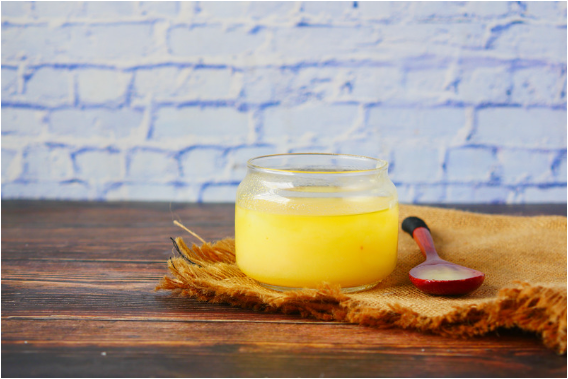
Ghee, also known as clarified butter, has been a staple in Indian cuisine and Ayurvedic medicine for thousands of years. Revered for its rich flavor and numerous health benefits, ghee is more than just a cooking ingredient. It plays an essential role in maintaining overall health, particularly in improving digestion, supporting nerve health, and balancing cholesterol levels.
What is Ghee?
Ghee is made by heating butter to separate the milk solids and water content, leaving behind pure fat. This process of clarification enhances its shelf life and makes it easier to digest compared to regular butter.
Composition of Ghee
- Saturated Fats: Ghee contains a significant amount of saturated fats, which provide stability and durability for cooking at high temperatures. Saturated fats are crucial for cell function, hormone production, and energy storage.
- Unsaturated Fats: Though mostly made up of saturated fats, ghee also contains a smaller proportion of unsaturated fats, including essential fatty acids like oleic acid, which are beneficial for heart health.
- Fatty Acids (Palmitic and Oleic): Ghee contains important fatty acids like palmitic and oleic acids, both of which contribute to various health benefits, especially supporting the nervous system and promoting overall wellness.
Health Benefits of Ghee
Ghee is much more than a source of calories; it offers several health-promoting qualities that support the body in various ways.
1. Supports Nerve Health
Ghee is considered excellent for brain and nerve health. The healthy fats in ghee help to nourish the brain cells, improving cognitive function and potentially reducing the risk of neurological diseases. The presence of butyrate, a short-chain fatty acid, supports the production of neurotransmitters, further enhancing brain function.
- Key Benefit: Enhances cognitive function and supports the nervous system.
2. Digestive Health
Ghee is known to aid digestion due to its richness in butyrate, which supports the digestive tract lining. The beneficial fats help improve nutrient absorption and enhance the overall functioning of the gut. For those with digestive issues such as heartburn or gastric discomfort, ghee can be an effective remedy.
- For Gastric Issues: Ghee is especially beneficial for individuals who experience heartburn or digestive irritation. Consuming ghee in small amounts can soothe the stomach lining and improve digestion.
3. Promotes Heart Health
Contrary to popular belief, ghee, when consumed in moderation, can support heart health. The essential fatty acids in ghee help balance cholesterol levels and may contribute to reducing harmful LDL (low-density lipoprotein) cholesterol. The oleic acid found in ghee also has anti-inflammatory properties, which are beneficial for heart health.
- Cholesterol Levels: While ghee contains saturated fats, they do not necessarily contribute to an increase in bad cholesterol. When consumed in moderation, ghee helps balance overall cholesterol levels, contributing to heart health.
4. Rich in Antioxidants
Ghee is rich in antioxidants such as vitamins A and E, which help fight oxidative stress and protect the body against free radical damage. These antioxidants play a role in reducing inflammation and supporting the immune system.
- Antioxidant Protection: Ghee supports skin health, helps in healing wounds, and may even contribute to slower aging by neutralizing the effects of free radicals.
Ghee and Hypercholesterolemia: A Clinical Perspective
Hypercholesterolemia, a condition where cholesterol levels are elevated due to genetic factors or liver inefficiency, can cause concerns when it comes to consuming fats like ghee. However, it’s important to understand that not all fats are harmful.
1. Ghee in the Context of Cholesterol Management
- Cholesterol Levels and Liver Function: In cases of hypercholesterolemia, the liver may not be processing cholesterol effectively, leading to persistently high cholesterol levels. Despite this, moderate consumption of ghee is not harmful, as long as other aspects of the diet are monitored carefully.
- Supporting the Liver: Individuals with high cholesterol should focus on liver health. Using herbs like curcumin (from turmeric) and milk thistle can support liver function, helping it process cholesterol better.
2. Managing Diet and Fats
For individuals with high cholesterol, it is not necessary to eliminate ghee completely. Instead, the focus should be on managing the overall fat intake and ensuring a balanced diet.
- Carb Cycling: Reducing simple carbohydrates (like sugary foods) is important, while consuming complex carbohydrates in moderation helps support liver health and balance cholesterol levels.
How to Include Ghee in Your Diet
While ghee is a nutritious food, it’s essential to consume it in moderation to gain its full benefits. Here are some tips for incorporating ghee into your diet:
- Daily Consumption: A healthy individual can safely consume 5 to 10 grams of ghee daily. This can be added to your meals in small amounts, such as on cooked vegetables, rice, or bread.
- For Digestive Support: For individuals with digestive issues like heartburn, ghee can be consumed in the morning and with lunch to help soothe the stomach.
- Culinary Uses: Ghee is excellent for cooking because it has a high smoke point, making it ideal for frying, sautéing, and even baking.
Ghee as a Holistic Food for Health
Ghee is not just a flavorful addition to your meals; it is a powerhouse of health benefits. From supporting nerve and brain health to improving digestion and maintaining heart health, ghee can be a valuable part of a balanced diet. Its rich composition of saturated and unsaturated fats, along with its antioxidant properties, makes it an essential part of holistic wellness.
For individuals with specific health concerns like hypercholesterolemia, ghee can still be enjoyed, provided it is consumed in moderation and alongside a liver-supportive diet. As with any food, balance is key, and ghee should be seen as a beneficial addition when incorporated thoughtfully into a well-rounded, healthy lifestyle.
The Incredible Benefits of Milk Thistle for Liver Health and Digestion
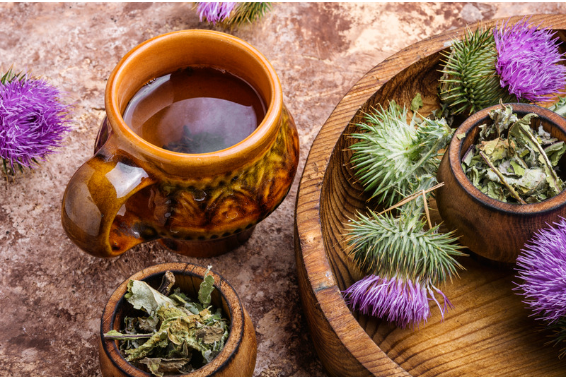
Milk thistle, known scientifically as Silybum marianum, is a powerful herb renowned for its liver-supporting properties. This hardy plant is native to Europe and North America but is now widely cultivated across various parts of the world due to its extensive health benefits. Here’s an in-depth look at how Milk Thistle can enhance liver health, support digestion, and contribute to overall wellness.
1. Milk Thistle: An Overview
Milk Thistle has been used for thousands of years for its therapeutic properties. The active compound in Milk Thistle, Silymarin, is derived from its seeds and is primarily known for its ability to protect and regenerate liver cells.
Key Benefits:
- Hepatoprotective: Protects liver cells from damage and promotes liver regeneration.
- Choleretic: Stimulates bile production, aiding in fat digestion.
- Cholagogic: Helps the gallbladder empty fully, reducing the risk of gallstones.
2. Liver Protection and Regeneration
The liver is one of the most vital organs in the body, responsible for detoxifying harmful substances and aiding digestion. Milk Thistle is known to protect the liver in multiple ways:
- Hepatoprotective Action: Silymarin in Milk Thistle protects hepatocytes (liver cells) from oxidative damage caused by toxins, alcohol, and environmental pollutants.
- Liver Regeneration: The liver has a remarkable ability to regenerate itself, and Milk Thistle plays a crucial role in stimulating this process, especially when the liver has been exposed to prolonged stress or injury. It can regenerate up to 70% of its original capacity under the right conditions.
How It Works:
- Milk Thistle supports the liver’s detoxification process by aiding the regeneration of liver cells and enhancing liver function.
- It helps reduce inflammation and scarring in the liver, making it a powerful ally in preventing conditions like NAFLD (Non-Alcoholic Fatty Liver Disease).
3. Supporting Gallbladder Function
Milk Thistle is also beneficial for the gallbladder, the organ responsible for storing bile produced by the liver. Bile is essential for the digestion of fats, and any stagnation or improper functioning of the gallbladder can lead to gallstones or poor digestion of fats.
Key Points:
- Choleretic Action: Milk Thistle stimulates the liver to produce bile, which helps with fat digestion and absorption.
- Cholagogic Action: It helps in the complete emptying of the gallbladder, preventing the formation of gallstones caused by bile stagnation.
- Supports Fat Digestion: People with sluggish bile flow often suffer from poor fat digestion, resulting in symptoms like dry skin, fatigue, and weight gain. Milk Thistle helps in improving fat digestion and alleviating these symptoms.
4. Improved Digestion and Detoxification
Milk Thistle plays a role in supporting the digestive system, particularly for those struggling with digestive issues like IBS (Irritable Bowel Syndrome) or chronic bloating. It helps the liver detoxify harmful substances and ensures that the digestive system works efficiently.
Benefits:
- Digestive System Support: The liver’s function directly impacts overall digestion. By supporting liver detoxification and bile production, Milk Thistle ensures smooth digestion, especially of fats.
- Promotes Better Fat Metabolism: Fat digestion is crucial for overall health. If you suffer from issues like greasy stools, bloating, or abdominal weight, Milk Thistle could help improve fat metabolism and reduce digestive discomfort.
5. Milk Thistle and Liver Detoxification
In addition to its regenerative capabilities, Milk Thistle is an excellent detoxifying herb. It helps to remove harmful substances from the body, reducing the strain on the liver and improving overall health.
- Liver Detoxification: By promoting the production of bile and supporting liver regeneration, Milk Thistle acts as a natural detoxifier. It helps in breaking down and eliminating toxins from the body, improving liver function and overall health.
6. Milk Thistle for Weight Management
One of the secondary benefits of Milk Thistle is its potential role in weight management, especially in those with liver-related issues.
- Balances Hormones and Thyroid Function: Milk Thistle helps in balancing hormones and improving thyroid function, which can be critical for maintaining a healthy weight.
- Reduces Abdominal Weight: Some people suffering from liver dysfunction experience weight gain, particularly around the abdomen. Milk Thistle, by improving liver function, may help in reducing abdominal fat and overall body weight.
7. How to Use Milk Thistle
Milk Thistle can be consumed in various forms, including capsules, seeds, and powder. For optimal results, it’s essential to follow the correct dosage and timing.
Recommended Dosage:
- Capsules: 400-600 mg of Milk Thistle daily is considered safe and effective.
- Seeds: Milk Thistle seeds can be consumed directly or ground into a powder. The seeds retain fiber, fat, and provide a delicious, healthy addition to meals.
Important Note:
- Milk Thistle should be taken at least 1 hour after medications as it can interfere with the absorption of certain medications.
- For those who prefer a natural form, Milk Thistle seeds can be consumed directly, retaining their full nutritional value.
8. Case Study: A Successful Milk Thistle Treatment
A 60-year-old female patient suffering from IBS with diarrhea was experiencing gray, greasy stools, poor fat digestion, fatigue, and a bloated abdomen. Despite losing muscle mass, her abdomen appeared distended, resembling pregnancy. Blood tests revealed elevated liver markers, which indicated liver dysfunction.
- Diagnosis: Her condition was a clear indication of poor liver function and fat digestion.
- Treatment: Incorporating Milk Thistle into her treatment plan helped regulate her liver function, improve fat digestion, and reduce the symptoms of IBS and fatigue.
- Outcome: The patient saw significant improvements in her digestion, energy levels, and overall well-being after using Milk Thistle.
Why Milk Thistle Should Be Part of Your Wellness Routine
Milk Thistle is a versatile herb with potent liver-protective, digestive, and detoxifying properties. Whether you’re dealing with liver conditions like NAFLD or simply looking to improve digestion, Milk Thistle can be an excellent addition to your wellness routine. Always ensure you’re using it under proper guidance, especially if you’re on medications, to maximize its benefits.
By incorporating Milk Thistle into your lifestyle, you can help your body regenerate, detoxify, and optimize digestion for a healthier, more energetic life.
The Power of Moong Dal: A Superfood for Health and Wellness
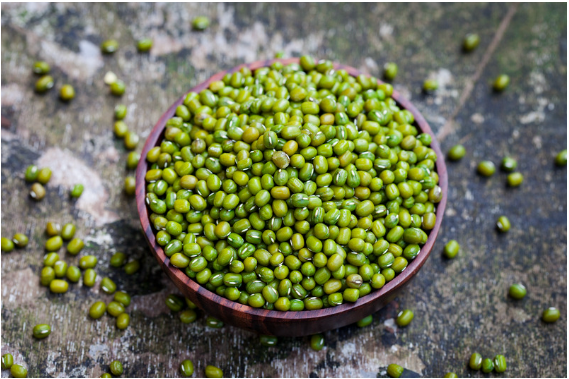
Moong dal, commonly known as green gram, is a powerhouse of nutrients and an essential superfood for maintaining overall health. From improving immune function to offering a plant-based protein source, this humble dal is a must-have in your diet. Here’s why moong dal is considered a superfood, especially from a naturopathic perspective.
Key Nutrients in Moong Dal
Moong dal is a rich source of several essential nutrients that contribute to its superfood status. Let’s break them down:
- Zinc: Moong dal is packed with zinc, a mineral that plays a crucial role in immune function, wound healing, and protein synthesis. Zinc also aids in the breakdown of carbohydrates, making it beneficial for people with diabetes.
- Magnesium: Rich in magnesium, moong dal is known for its ability to relax smooth muscles, making it an excellent choice for people experiencing abdominal cramps or other digestive issues.
These nutrients make moong dal an invaluable part of a healthy diet.
Health Benefits of Moong Dal
1. Immune Function Boost
Zinc, found abundantly in moong dal, is vital for the immune system. It helps fight off infections and supports the body’s defense mechanisms. This is why moong dal is recommended for individuals with compromised immunity.
2. Cardiovascular Health
Moong dal offers cardioprotective benefits, which can help lower blood pressure and reduce the risk of heart disease. The magnesium content further helps by promoting relaxation of the blood vessels, improving blood circulation.
3. Blood Sugar Regulation
Moong dal is beneficial for those struggling with blood sugar issues. The high fiber and low glycemic index properties of moong dal help regulate blood sugar levels, making it an excellent food choice for diabetics.
4. Protein Source for Vegetarians
For vegetarians who often face protein deficiencies, moong dal provides a fantastic source of plant-based protein. It is easily digestible, making it suitable for people of all ages, including children, athletes, and the elderly.
Why Moong Dal is Easy to Digest
The magnesium in moong dal plays a significant role in digestion. Magnesium helps relax the smooth muscles of the digestive tract, reducing issues like bloating and cramps. Additionally, the high fiber content in moong dal promotes healthy bowel movements and gut health.
Ways to Include Moong Dal in Your Diet
To maximize the nutritional benefits of moong dal, consider incorporating it in various forms:
1. Sprouted Moong Dal
Sprouting moong dal makes its protein more bioavailable and breaks down the fiber, making it easier to digest. You can sprout it at home or buy pre-sprouted versions. Sprouted moong dal is especially beneficial for those looking to improve their protein intake.
2. Roast and Powdered Moong Dal
Roasting and powdering moong dal helps to increase its shelf life, making it a convenient pantry staple. It also enhances the flavor and nutritional density. Roasted moong dal powder can be added to smoothies, soups, or homemade energy bars.
3. Moong Chilka (Whole Green Moong)
Always prefer whole green moong with the pericarp (skin), as it retains more nutrients than split moong dal. Moong chilka is rich in fiber and offers a more complete nutrient profile.
Special Considerations for Consuming Moong Dal
While moong dal offers numerous benefits, there are a few things to keep in mind:
- Avoid Raw Moong Dal: Raw moong dal can be difficult to digest. It’s better to consume it sprouted, cooked, or roasted to aid digestion and avoid any digestive discomfort.
- Add Lemon for Better Absorption: To enhance the absorption of nutrients, especially iron, always add a dash of lemon to moong dal dishes. Vitamin C helps the body absorb iron more effectively.
- Moderate Portions for Dinner: Moong dal is best consumed during lunch or breakfast. Avoid large servings at dinner, as its high fiber content may cause digestive discomfort at night. Start with smaller portions to see how your body reacts.
- Sprouted Moong Dal for Athletes: For young athletes, such as swimmers, moong dal can be a great protein alternative to whey protein shakes. A simple blend of sprouted moong dal, ragi (finger millet), and cardamom can be an excellent recovery drink.
Moong dal is more than just a basic ingredient in Indian cuisine; it’s a powerhouse of essential nutrients that promotes health in various ways. From supporting immune function to aiding digestion and regulating blood sugar levels, moong dal is a versatile superfood. Whether you consume it sprouted, roasted, or as part of a blend, make sure to include it in your diet for optimal health. Remember, incorporating moong dal into your meals can have long-lasting positive effects on your overall wellness.
The Nutritional Benefits of Curd, Yogurt, and Buttermilk: A Complete Guide to Gut and Heart Health
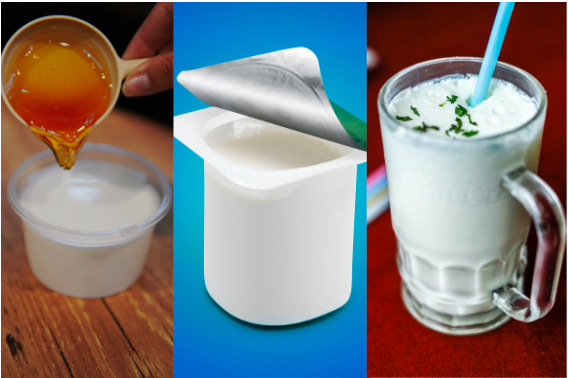
Curd (yogurt) and buttermilk are not only common ingredients in many cuisines but are also celebrated for their health benefits. Whether you are looking to improve your digestion, boost your immune system, or maintain a healthy heart, these dairy products can play a key role in your diet. This article explores the multiple nutritional benefits of curd, its difference from yogurt, and why buttermilk is also an excellent addition to your daily regimen.
Curd: A Protein Powerhouse
Curd, made by fermenting milk with beneficial bacteria, is an excellent source of protein, which is essential for the body’s growth, repair, and overall function. Curd contains a high concentration of protein that helps in muscle repair and supports immune health. The whey protein found in curd is one of the most easily absorbed forms of protein, helping in muscle-building and improving body composition.
Protein is essential for everyone, especially for vegetarians who might lack other natural protein sources. Including curd in your diet provides an easy and delicious way to meet your protein requirements.
Probiotic Benefits for Digestive Health
One of the most significant health benefits of curd is its probiotic content. Probiotics are live bacteria that promote a healthy gut and digestive system. The lactic acid bacteria found in curd, particularly Lactobacillus, help balance the gut microbiome by promoting the growth of good bacteria and suppressing harmful bacteria.
The probiotics in curd can help alleviate common digestive issues such as constipation, bloating, and indigestion by enhancing the body’s ability to digest food. Furthermore, a healthy gut is crucial for a strong immune system, and probiotics in curd support immunity by promoting good gut bacteria.
Consuming curd regularly can keep your digestive system functioning optimally, making it a beneficial addition to your daily diet.
Rich Source of B Vitamins
Curd is a great source of several important B vitamins, which are crucial for overall health and wellness. B vitamins play a critical role in energy production, helping convert the food you eat into usable energy. This makes curd an excellent food for boosting stamina throughout the day. Additionally, B vitamins, especially B2 (riboflavin) and B12, support healthy skin and hair. Regular consumption of curd can contribute to better skin texture and a healthy scalp.
These vitamins are especially important for people who may be lacking in these nutrients due to dietary restrictions or health conditions. Including curd in your diet can help you meet your daily vitamin needs.
Potassium for Heart Health
Curd is a rich source of potassium, an essential mineral that supports several bodily functions. Potassium helps in maintaining the balance of fluids in the body and counteracts the effects of sodium, which helps keep blood pressure levels in check. Adequate potassium intake is vital for maintaining proper heart function and preventing cardiovascular diseases.
Incorporating curd into your diet can support a healthy heart and help regulate blood pressure, reducing the risk of heart-related issues.
Curd vs. Yogurt: What’s the Difference?
Many people confuse curd with yogurt, but they are distinct in terms of preparation and health benefits. Curd is traditionally made by fermenting milk with lactic acid bacteria, which are naturally present in the environment or added during preparation. The bacteria in curd can vary, offering a wider range of beneficial microbes. In contrast, yogurt is made by fermenting milk with specific strains of bacteria, such as Lactobacillus bulgaricus and Streptococcus thermophilus, which are more consistent and commercially produced. While yogurt is also probiotic, it may not offer the same diversity of bacteria that fresh, home-set curd does.
While both curd and yogurt are beneficial, curd made at home may provide more natural bacteria, giving it a slight edge in promoting gut health.
Buttermilk: The Digestive Elixir
Buttermilk, or chaas, is the liquid remaining after curd is churned to make butter. It is a lighter and more hydrating version of curd that offers additional health benefits. Buttermilk is particularly beneficial in hot climates due to its cooling properties. It helps prevent dehydration and provides relief from heat-related ailments.
Buttermilk is easy to digest and helps soothe the stomach lining. It can relieve acidity, indigestion, and bloating. Compared to curd, buttermilk is lower in fat and calories, making it a great option for those who are looking to manage their weight. Drinking buttermilk regularly can aid in digestion, maintain hydration levels, and support overall wellness.
Curd, Yogurt, and Buttermilk: A Healthy Trio for Gut Health
The primary reason curd, yogurt, and buttermilk are often referred to as gut-friendly foods is due to their probiotic content. Probiotics play a crucial role in maintaining a healthy gut microbiome, which, in turn, supports overall health. Probiotics help in restoring balance to the gut microbiome and preventing dysbiosis, which is an imbalance of gut bacteria that can lead to digestive issues and immune problems.
Additionally, probiotics aid in repairing the gut lining, improving nutrient absorption, and reducing inflammation. Including these dairy products in your diet ensures the maintenance of a healthy gut, contributing to better overall health.
Lactose Intolerance and the Benefits of Yogurt
While curd is beneficial for most people, individuals who are lactose intolerant may find yogurt a better alternative. Yogurt contains live bacteria that break down lactose during fermentation, making it easier to digest for those with lactose intolerance. For people with sensitive stomachs or digestive conditions, yogurt might be a gentler option than curd.
Yogurt provides a more digestible source of probiotics for those who struggle with lactose intolerance, making it an excellent option for improving gut health.
Including Curd, Yogurt, and Buttermilk in Your Diet
Curd, yogurt, and buttermilk are versatile, nutrient-dense foods that offer a range of health benefits. They are rich in protein, probiotics, B vitamins, and potassium, all of which contribute to better digestion, improved immunity, and heart health. Choosing fresh, home-set curd can provide you with the best probiotic benefits, while yogurt is a better choice for those with lactose intolerance.
Incorporating these dairy products into your daily diet is an easy way to boost your nutrition and support a healthy gut microbiome. Whether you prefer curd, yogurt, or buttermilk, each offers unique benefits that promote overall wellness.








